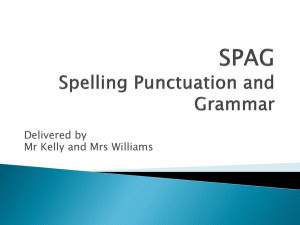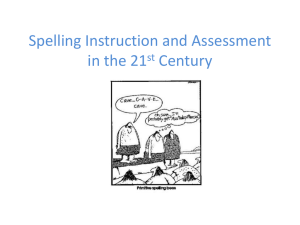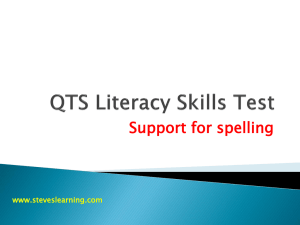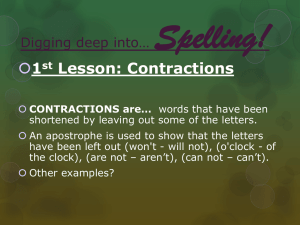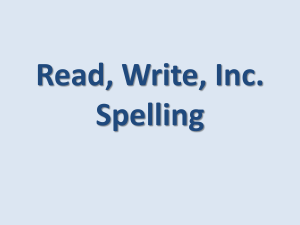Assessment for learning and teaching improvement: Lessons from
advertisement
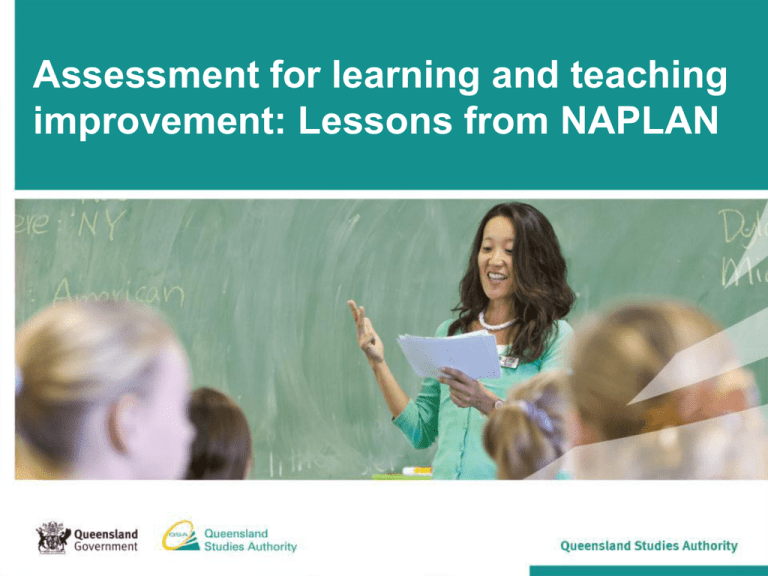
Assessment for learning and teaching improvement: Lessons from NAPLAN Reports and writing scripts The writing scripts are there until 30 November. Thank you for your support this year. Challenges for 2014 • The delivery period and the School/Easter holidays exactly coincide. • This will leave 8 days for delivery. We need you help to achieve a smooth delivery. You can help us: • by notifying us immediately materials are received through web-back • checking straightaway to make sure that all materials are there • ordering any extra materials straightaway. Summary of the information with the EQ announcement • Queensland’s improvement journey continues in 2013 • Queensland is the most improved state 2008-13 and 201213 • Year 5 students have improved in all 5 areas since 2012 and in 4 out of the 5 test result areas the 2013 Queensland results are best on record for this year level • Year 3 results are also strong with all 5 areas improved over 2008 and further improvements in 3 out of 5 test result areas over 2012 to produce best on record results in these areas • Writing continues to represent a challenge, particularly at Year 9 Summary of the information with the EQ announcement • Reading results are strong across the board with >92% of students achieving the NMS at every year level • Participation has shown a further slight decline – particularly withdrawn students • Queensland typically ranks below the ACT, NSW & VIC, clusters with WA, SA and TAS and is above NT • Queensland ranks 4th at Years 3 & 5 overall for NMS and MSS • At Year 7 Qld ranks 6th for both NMS and MSS and at Year 9 Qld ranks 5th for NMS and 6th for MSS. Some facts for 2013 On distribution • 1 698 000 testbooks and stimulus materials were printed • 260 000 test administration books were printed • 710 000 testbooks are overprinted • 7 000 packages were distributed to 1784 school sites — 4000 packages of the actual tests. On return • 6 million pages are scanned and processed resulting in 12 million images • 478 markers working in two shifts mark the writing • 100 data entry operators verified the scanned resulting data making more than 40 million keystrokes • 237 000 reports will be sent to schools. Testbooks are overprinted for 237 000 students. Writing • Schools will not be notified of the genre. • Writing was better this year – less of the formula Possible teaching emphasis • Craft of writing • Developing voice • Development of mature sentence structures. Assessment is part of the teaching–learning cycle. The fatal weakness remains: going from assessment to instruction. (Fullan et al, 2006) All school staff need the skills and ability to turn raw data from many different sources into meaningful information that they and others understand and can act upon. (Newman, King & Rigdon, 1997) Our current challenge is to use assessment — all assessment — to inform teaching and learning. To move from being data collectors data givers data users Assessment for learning and teaching improvement Tier 1: accountability indicators — district/state/nationwide measures results Tier 2: accountability indicators — school and class level measures causes Tier 3: accountability — the narrative that gives the story ‘behind the numbers’. Tier 1: accountability indicators — district/state/nationwide measures results • International — PISA, TIMMS, I.B. • National — NAPLAN, NAP Sample tests – science, C&C, I.C.Ts • District/ — Normed tests Diocesan/ Diagnostic tests Schools Inventories Surveys Tier 1: accountability indicators — district/state/nationwide measures results • System-wide — used by everyone • Clear — broad intent and application is obvious to all stakeholders • Stable — consistent targets • Aligned — support system goals • Focused — minimal in number. Tier 2: accountability indicators — school and class level measures causes Qualitative • Reading conferences • Portfolios • Think alouds • Running records, IRIs, Miscues • Spelling inventories • Surveys Quantitative • Standardised tests • Teacher-made tests • Running records, IRIs, Miscues • Spelling inventories • Surveys Tier 2: accountability indicators — school and class level measures causes • Relevant • Measurable • Continuous • Timely — to specific school needs — expressed in numbers or percentages — measured and analysed regularly through the year — act as early warning signs and allow teachers/administrators to refine or change approaches. Tier 3: accountability — the narrative that gives the story ‘behind the numbers’. It is the narratives behind the data that are: • the building blocks of school improvement • a catalyst for professional learning. Tier 1: accountability indicators — district/state/nationwide measures results Curriculum question Curriculum leadership question Ways of analysing the data • Performance on key concepts • Investigating common incorrect responses • Comparing results against the State and National mean. So when do you add -able and when –ible? What’s the convention? 21% M 21% F 22% A 18% obediance (9%), disipline (6%), manageble (5%), dicipline (4%), managible (4%) 27% 50.1% Year 7 valueble (4%), presious (3%), valable (2%), minaral (1%), precious (1%) 53.2% enterprize (4%), enterprice (3%), fluctations (2%), fluctuations (2%), flunctuations (1%) 61% M 58 F 65 A 63% relieable (4\%), realyable (3\%), rellyable (3\%), relyable (2\%), relayable (2\%) 38% M 32 F 44 A 36% responsabilities (4\%), responsabilites (3\%), responsebilities (3\%), responsibilites (2\%), responsabilitys (2\%) 70% M 64% F 75% guidence (3%), considirable (1%), considable (1%), conciderable (1%), instructer (1%) A 69% Spelling — error identified — 2013 straight strate (4%), stright (2%), straght (1%), straite (1%), strat (1%) ordinary urban ordanary (4%), ordenary (2%), ordinery (1%), ordanry (1%), ordenry (1%) urbin (3%), urbun (2%), urburn (2%), urbon (2%), urbern (1%) catchment accomplishment circuit cachement (3%), cachment (1%), cashment (1%), cachtment (1%), cachmant (<1%) acomplishment (5%), acommplishment (2%), acompleshment (1%), acomplisment (1%), accomplisment (1%) circit (6%), circute (4%), curcit (3%), circet (3%), circut (2%) monitor monitar (8%), moniter (5%), moneter (4%), monater (3%), monniter (3%) structural canyon structurel (11%), structual (10%), structurall (8%), structuall (2%), structurell (1%) cannion (16%), canon (8%), cannon (6%), canion (3%), canian (2%) deafening deffening (13%), defining (11%), deafining (3%), defending (3%), defenning (2%) practically practicaly (14%), practiclly (4%), practicly (3%), practicley (3%), practicely (2%) campaign campain (21%), campaine (6%), campaigne (5%), campagne (3%), compane (1%) nurture nurcher (8%), nerchure (6%), nuture (4%), nurchure (3%), nurtchure (3%) jeopardy jeperdy (16%), jepordy (12%), jeprady (3%), jepardy (3%), jepoardy (2%) incorparated (17%), incorperated (8%), incorpperated (5%), incorrperated (3%), incorporated inccorperated (2%) acquired aquired (11%), aquirred (10%), aqquired (8%), equired (6%), aquiered (3%) Spelling errors — unidentified — 2013 garbage (86) goverments (1%), garbadge (1%), garbedge (1%), garbige (1%), garbge (1%) classify (80) clasify (1%), weather (1%), wheather (1%), suitable (1%), classefy (1%) imaginitive (2%), imaginative (2%), contributed (1%), imagenative (1%), imagineative (1%) polution (5%), confinned (2%), conffined (1%), confined (1%), minnimum (1%) weird (63) southern deforestation deforrestation (3%), habbitats (3%), severly (2%), severaly (1%), threatend (1%) guidence (3%), considirable (1%), considable (1%), conciderable (1%), considerable instructer (1%) fulfilling fullfilling (7%), fullfiling (6%), submiting (5%), forfilling (4%), fufilling (3%) schedule schedual (3%), scedule (3%), efficent (2%), shcedule (2%), afficient (2%) gourmet apreciates (5%), gorment (4%), ingrediants (4%), gormat (3%), gormet (2%) enzymes exhilaration protiens (21%), added (7%), ensimes (4%), aidded (4%), enzimes (2%) permenantly (11%), permently (5%), perminently (3%), permanantly (2%), permenatly (2%) exileration (16%), exhileration (6%), overwelming (4%), exillaration (4%), exhiliration (3%) vacuum vacum (8%), vaccuum (7%), sucktion (6%), vaccume (5%), extendible (4%) dilemma deserts (15%), dillema (10%), envyable (4%), delema (3%), inviable (3%) permanently The basic premise of our discussion Spelling is developing an understanding of the whole system of English orthography. What it is not ... memorising words. Spelling/orthographic knowledge? How pronunciation is coded. make, stay, seat rabbit, lizard, open composition How word function is coded jumped, cleaned, beaded education, explosion, magician How sounds are mapped onto letters. cat, dog Current models explain how English spelling codes deep linguistic knowledge. How meaning/derivational relationships are coded homophones – great/grate roots – aster, astrolabe, astronaut history – two, twelve, camouflage Key messages • Students are around 18 years old before they develop mature control over the English spelling system. • Spelling needs to be taught in secondary schools. • Spelling needs to be taught as a system and all aspects of the system need to be taught. • The spelling-meaning connection has a positive effect on vocabulary development. • Vocabulary development is critical to learning in the content areas. A focus on vocabulary will have positive on assessments such as the QCS test. • Students need to develop a spelling conscience. Teaching spelling is everyone’s responsibility. Ways of analysing the data • Performance on key concepts • Investigating common incorrect responses • Comparing results against the State and National mean. Spellers apply their knowledge in two modes Expressive Production — What students do when they focus all their cognitive resources on spelling, e.g. in class tests, word games discussions. Generation — What students can do when they produce spelling automatically, e.g. in writing. Receptive/ Recognition Proofreading — • own spelling, e.g. in writing • other’s spelling. What do the results for these words tell? 2013 18% M 15% F 22% A 20% exileration (16%), exhileration (6%), overwelming (4%), exillaration (4%), exhiliration (3%) 18% M16% F 20% A16% abreveation (11%), abriviation (10%), abreviation (8%), abrevation (6%), abrieviation (6%) 2012 54% M 54% G 55% A 40.7% precition (4%), presision (3%), precission (2%), presition (2%),precaution (2%) 14.6% M 13% F 16% A 18.9% reconsiliation (37%), reconsilliation (4%), reconsilation (4%), reconcilliation (3%), reconciliasion (2%) In upper primary and secondary schools Teach the high-yield affixes – the ones where the spelling stays reasonably stable and are high use. prefixes — un (not, opposite), pre (before), re (back, again), dis (not), mis (bad, wrong), uni (one), bi (two), tri (three), in/im/il/ir (not without), trans (across), post (after), anti (against), de (down) etc Suffixes — y/ ly (like), er (comparative), est (superlative), less (without), ness (condition), ful (full of, like), ar/er/or (one who), ment (result, action, condition), able/ible (capable of, likely to), ance/ence etc • Teach them with words they know in a context they know before adding newer words in both spelling and vocabulary Build knowledge of Latin and Greek roots. These are used to create words in different learning areas. Greek roots are easier. The spelling is more stable and thus recognisable. o therm (heat) — thermometer, thermal, thermostat o graph (write) — autograph, biography, graphics Build from common Latin roots o vis/vid (see) — visual, vision, video, television o dict (say) — dictate, dictation, diction, predict. Note the surprising results 2013 Key 7% 59% M 22% M 8% M 63% F 26% F 7% F 55% 24% Key 30% 2nd 13% M 14% 2012 F 12% Key 2nd 29 % 33% M 32% M 31% F 27% F 34% Ways of analysing the data • performance on key concepts • investigating common incorrect responses • comparing results against the State and National mean. 2013 calculator allowed 2012 calculator allowed 100 100.0 90 90.0 80 80.0 70 70.0 60 60.0 Aust 2012 50 50.0 40 40.0 30 30.0 20 20.0 10 10.0 0 0.0 CA CA CA CA CA CA CA CA CA CA CA CA CA CA CA CA CA CA CA CA CA CA CA CA CA CA CA CA CA CA CA CA 1 2 3 4 5 6 7 8 9 10 11 12 13 14 15 16 17 18 19 20 21 22 23 24 25 26 27 28 29 30 31 32 2013 non calculator 2012 Non calculator 100 100.00 90 90.00 80 80.00 70 70.00 60 60.00 50 50.00 Qld Aust 40 40.00 30 30.00 20 20.00 10 10.00 0 0.00 NC NC NC NC NC NC NC NC NC NC NC NC NC NC NC NC NC NC NC NC NC NC NC NC NC NC NC NC NC NC NC NC 1 2 3 4 5 6 7 8 9 10 11 12 13 14 15 16 17 18 19 20 21 22 23 24 25 26 27 28 29 30 31 32 Calculator allowed 56 175 14% 14% QLD 75 7% 17% Aust 50 7% 60 3% 2nd 4% Key 81% M 3% M: 84% F 4% F 77% Literacy of numeracy 2nd Key 52% M 53% F 51% 15% M 16% F 14% 2nd Key 63% M 64% F 61% 14% Who does this best? 5% 69% M 66% F 71% +7% +9% +9% 7% 6% 2012 +6% Tier 1: accountability indicators — district/state/nationwide measures results Curriculum question Curriculum leadership question Guiding assumptions for data-driven collaborative inquiry. • Data have no meaning. • Knowledge is both a personal and social construction. • There is a reciprocal influence between the culture of the workplace and the thinking and behaviour of its members. • Understanding should precede planning. You don’t need an advanced degree in statistics and a roomful of computers to start asking data-based questions about your school and using what you learn to guide reform. Victoria Bernhaus A theory of action for schools Although student outcomes are deeply affected by forces beyond the school, such as socioeconomic status, schools play an important role in what happens to students. We do not know the limits of human capacity to improve; all we know is that we have not yet reached those limits and that people continue to surprise us with their abilities to achieve and their resilience, sometimes in the face of enormous obstacles. The heart of school improvement rests in improving daily teaching and learning practices in schools, including engaging students and their families. . Key 33% M 34% F35 % 2nd 7%

